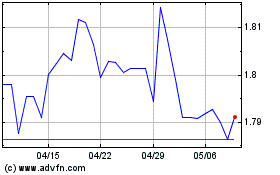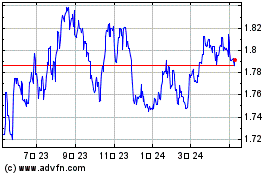Euro Slides As German Industrial Orders Decline Unexpectedly
The euro dropped against its most major counterparts in the
European session on Monday, as an unexpected decline in German
factory orders supported hopes that the European Central Bank may
delay the unwinding of its extraordinary stimulus measures.
Figures from Destatis showed that Germany's factory orders
declined unexpectedly in March. Factory orders dropped 0.9 percent
month-on-month in March, bigger than the revised 0.2 percent
decrease in February.
Orders were expected to climb 0.5 percent.
German bund yields fell, with the yield on 10-year note dropping
0.53 percent in European trading.
Adding to caution, survey data from think tank Sentix showed
that Eurozone investor confidence weakened for the fourth straight
month in May.
The investor sentiment index fell unexpectedly to 19.2 in May
from 19.6 in April. The score was forecast to rise to 22.4.
The currency showed mixed trading against its major opponents in
the Asian session. While it fell against the greenback and the
pound, it held steady against the franc. Against the yen, it
rose.
The euro weakened to a 4-day low of 0.8801 against the pound,
from a high of 0.8841 hit at 5:00 pm ET. The euro is seen finding
support around the 0.86 level.
The 19-nation currency reversed from an early high of 1.1978
against the greenback, falling to 1.1922. The euro is likely to
find support around the 1.17 mark.
The single currency eased back to 130.21 against the yen, after
rising to 130.59 at 7:15 pm ET. The next possible support for the
euro is seen around the 129.00 area.
The euro edged down to 1.5848 against the aussie and 1.5338
against the loonie, from its early highs of 1.5916 and 1.5392,
respectively. The euro is poised to challenge support around 1.56
against the aussie and 1.52 against the loonie.
The euro slid to more than a 2-week low of 1.6999 against the
kiwi, and held steady thereafter. On the downside, 1.68 is likely
seen as the next support for the euro.
On the flip side, the common currency climbed to a weekly high
of 1.1979 against the Swiss franc, reversing from an early low of
1.1948. If the euro continues its rise, 1.21 is possibly seen as
its next resistance level.
Data from the Federal Statistical Office showed that
Switzerland's consumer price inflation remained stable in
April.
Consumer prices climbed 0.8 percent year-on-year in April, the
same rate of increase as seen in March. Prices were expected to
gain 0.9 percent.
Looking ahead, at 8:25 am ET, Atlanta Fed President Raphael
Bostic will give opening remarks at the Federal Reserve Bank of
Atlanta's 23rd Annual Financial Markets Conference in Florida.
Richmond Fed President Thomas Barkin will deliver a speech at
George Mason University in Virginia at 2:00 pm ET.
U.S. consumer credit for March is scheduled for release in the
New York session.
Euro vs NZD (FX:EURNZD)
FXチャート
から 3 2024 まで 4 2024

Euro vs NZD (FX:EURNZD)
FXチャート
から 4 2023 まで 4 2024
